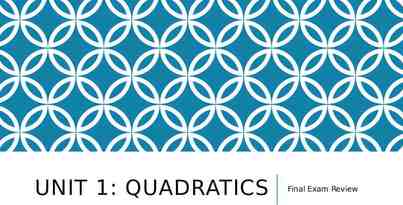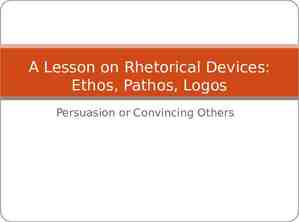Cryptography CS 555 Topic 1: Overview of the Course & Introduction to
22 Slides416.50 KB
Cryptography CS 555 Topic 1: Overview of the Course & Introduction to Encryption CS 555 Topic 1 1
See the Course Homepage CS 555 Topic 1 2
Goals of Cryptography The most fundamental problem cryptography addresses: ensure security of communication over insecure medium What does secure communication mean? – confidentiality (privacy, secrecy) only the intended recipient can see the communication – integrity (authenticity) the communication is generated by the alleged sender What does insecure medium mean? – Two possibilities: Passive attacker: the adversary can eavesdrop Active attacker: the adversary has full control over the communication channel CS 555 Topic 1 3
Approaches to Secure Communication Steganography – “covered writing” – hides the existence of a message – depends on secrecy of method Cryptography – “hidden writing” – hide the meaning of a message – depends on secrecy of a short key, not method CS 555 Topic 1 4
Terms: Cryptography, cryptanalysis, and cryptology Cryptography, – Traditionally, designing algorithms/protocols – Nowadays, often synonym with cryptology Cryptanalysis – Breaking algorithms/protocols Cryptology: both cryptography & cryptanalysis – Becoming less common CS 555 Topic 1 5
What Cryptography is About? Constructing and analyzing protocols which enables parties to achieve objectives, overcoming the influence of adversaries. – a protocol (or a scheme) is a suite of algorithms that tell each party what to do How to devise and analyze protocols – understand the threats posed by the adversaries and the goals CS 555 Topic 1 6
A Sample List of Other Goals in Modern Cryptography Modern cryptography covers many topics beyond secure communication – – – – – – – Pseudo-random number generation Non-repudiation: Digital signatures Zero-knowledge proof Commitment schemes E-voting Secret sharing Secure Multi-party Computation (Secure Function Evaluation) – CS 555 Topic 1 7
History of Cryptography 2500 years An ongoing battle between codemakers and codebreakers Driven by communication & computation technology – paper and ink (until end of 19th century) – cryptographic engine & telegram, radio Enigma machine, Purple machine used in WWII – computers & digital communication CS 555 Topic 1 8
Major Events in History of Cryptography Mono-alphabetical ciphers (Before 1000 AD) Frequency analysis (Before 1000 AD) Cipher machines (early 1900’s) Shannon developed theory of perfect secrecy and information theoretical security (around 1950) US adopts Data Encryption Standard in 1977 Notion of public key cryptography and digital signatures introduced (1970 1976) The study of cryptography becomes mainstream in the research community (1976) Development of computational security and other theoretical foundation of modern cryptography (1980’s) CS 555 Topic 1 9
What is This Course About? Mostly mathematical – Understand the mathematics underlying the cryptographic algorithms & protocols – Understand the power and limitations of cryptographic tools – Understand the formal approach to security in modern cryptography CS 555 Topic 1 10
Backgrounds Necessary for the Course A bit of probability Algorithms and complexity Mathematical maturity – understand what is (and what is not) a proper definition – know how to write a proof CS 555 Topic 1 11
Symmetric-key Encryption This is what cryptography is all about until 1970. Two parties (often called a sender and a receiver) share some secret information called a key. Sender uses the key to encrypt (or “scramble”) the message, before it is sent Receiver uses the same key to decrypt (or “unscramble”) and recover the original message CS 555 Topic 1 12
Basic Terminology for Encryption Plaintext – An original message – Also referred to as message Plaintext space (aka Message space) – the set consisting of all possible plaintexts Ciphertext – A scrambled message Ciphertext space – The set consisting of all possible scrambled message Key secret used in transformation Key space CS 555 K Topic 1 13
Notation for Symmetric-key Encryption A symmetric-key encryption scheme is comprised of three algorithms – Gen the key generation algorithm The algorithm must be probabilistic/randomized Output: a key k – Enc the encryption algorithm Input: key k, plaintext m Output: ciphertext c : Enck(m) – Dec the decryption algorithm Input: key k, ciphertext c Output: plaintext m : Deck(m) Requirement: CS 555 k m [ Deck(Enck(m)) m ] Topic 1 14
Shift Cipher The Key Space K : – [0 . 25] Encryption given a key k: – each letter in the plaintext P is replaced with the k’th letter following corresponding number (shift right) Decryption given k: – shift left History: k 3, Caesar’s cipher CS 555 Topic 1 15
Shift Cipher: Cryptanalysis Can an attacker find K? – YES: by a bruteforce attack through exhaustive key search, How to tell whether a shift is correct? – key space is small ( 26 possible keys). Cipher key space needs to be large enough. Exhaustive key search can be effective. CS 555 Topic 1 16
Mono-alphabetic Substitution Cipher The key space: all permutations of {A, B, C, , Z} Encryption given a key : – each letter X in the plaintext P is replaced with (X) Decryption given a key : – each letter Y in the cipherext P is replaced with -1(Y) Example: A B C D E F G H I J K L M N O P Q R S T U V W X Y Z B A D C Z H W Y G O Q X S V T R N M L K J I P F E U BECAUSE AZDBJSZ CS 555 Topic 1 17
Strength of the Mono-alphabetic Substitution Cipher Exhaustive search is difficult – key space size is 26! 4 1026 288 Dominates the art of secret writing throughout the first millennium A.D. Thought to be unbreakable by many back then How to break it? CS 555 Topic 1 18
Cryptanalysis of Substitution Ciphers: Frequency Analysis Basic ideas: – Each language has certain features: frequency of letters, or of groups of two or more letters. – Substitution ciphers preserve the language features. History of frequency analysis – Discovered by the Arabs; earliest known description is in a book by the ninth-century scientist al-Kindi – Rediscovered or introduced from the Arabs in the Europe during the Renaissance Frequency analysis made substitution cipher insecure CS 555 Topic 1 19
Frequency of Letters in English 14 12 10 8 Series1 6 4 2 0 a b c d e f CS 555 g h i j k l m n o p q Topic 1 r s t u v w x y z 20
How to Defeat Frequency Analysis? Use larger blocks as the basis of substitution. Rather than substituting one letter at a time, substitute 64 bits at a time, or 128 bits. – Leads to block ciphers such as DES & AES. Use different substitutions to get rid of frequency features. – Leads to polyalphabetical substituion ciphers, cipher machines, and stream ciphers CS 555 Topic 1 21
Coming Attractions Vigenere cipher. Required reading – Katz and Lindell: 1.1 to 1.3 Recommended reading – The Code Book: Chapters 1 to 4 CS 555 Topic 1 22



























